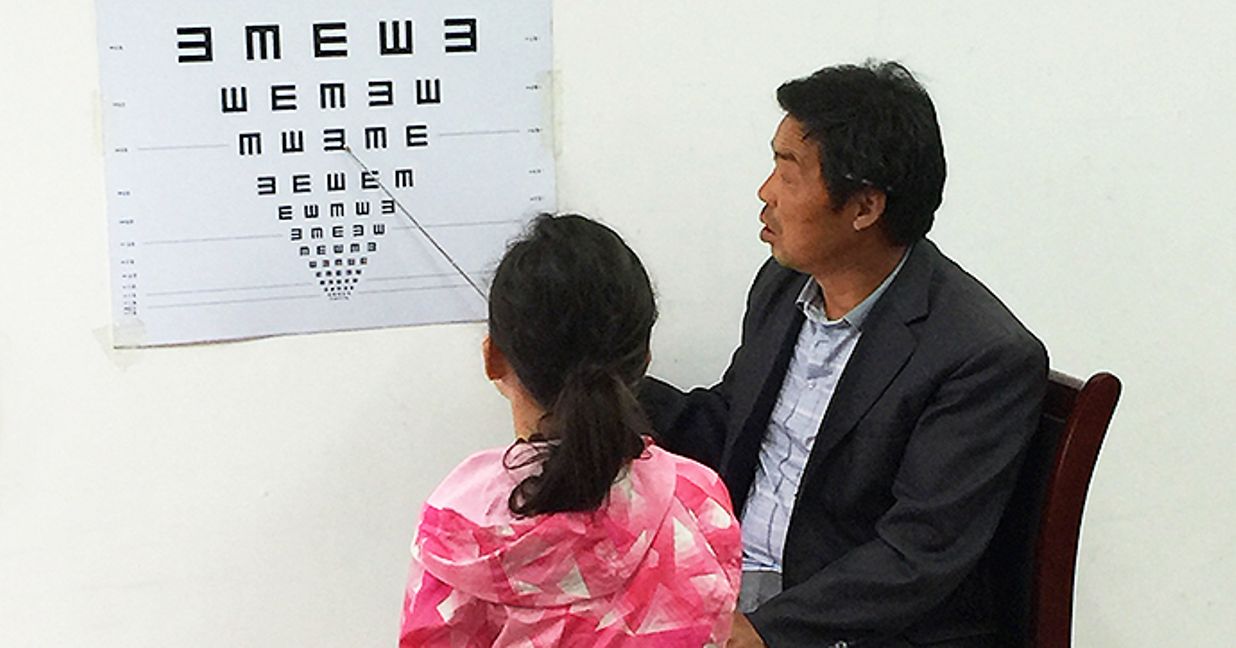We’re making progress, but the world’s vision crisis is far from over
Recently, I had the opportunity to review OneSight’s activities in Northwestern China where the organization is collaborating with SmartFocus, an offshoot of Stanford University’s Rural Education Action Program (REAP). The focus is building and operating vision centers for school children in and around Xi’an, the capital of the Shaanxi Province, on the eastern end of what’s known as the Silk Road in China.
I made this visit for my role as chairman of OneSight, a leading nonprofit in bringing vision care to the world, and I’m passionate about building awareness and financial support for OneSight’s global mission. In this rural interior of China, where millions still live in poverty, I was shocked by the prevalence and degree of need for vision correction. Unfortunately, not everyone in the world has easy access to vision care, and certainly not vision benefits programs like EyeMed.
She had to sit right in front of the screening chart
Two-thirds of China’s young people are growing up in these poor, rural areas [1], and more than 50% of middle school students need vision correction [2]. Compare that to the U.S., where 25% of school children need some type of vision correction. [3]
Moreover, in rural China the degree of the correction needed among students is very high—so high that a child without vision correction is truly impaired in seeing and severely compromised when learning in school.
Such degree of need was immediately evident among just 7 of the girls I saw who were screened in the Shaanxi Province, using the basic eye chart on the wall. The test is normally performed with the subject sitting about 10 feet away. One girl had to sit right in front of the screening chart, her knees practically touching the wall, to identify any of the symbols on the chart. That’s how diminished her vision was without glasses!
Encountering social-cultural resistance and economic barriers
Despite the huge need for vision correction in rural China, we grappled with social opposition to wearing eyeglasses. Girls, especially, still face a stigma if they wear glasses. Also, I learned that people in these areas believe massaging the area next to the eye or doing “eye exercises” will prevent or reduce refractive error, making glasses unnecessary.
And there is a financial burden associated with travel, the eye exam and naturally, the glasses themselves. For perspective, many families of 4 people in this area live in only 1 room. The cost for vision correction can create a real burden for them.
OneSight and SmartFocus are attempting to address all these barriers. Efforts range from leveraging teachers to counter concerns about social stigma (with the hope for better performance at school and a much better career later on) to creating seminars to dispel the “myth” that massages can help with bad vision to building vision centers and a logistical apparatus to make travel, eye exam and eyeglasses affordable and easy to access.
Improving vision has real impact
I am a data-driven, analytical person, and having Stanford’s REAP experts involved meant having access to critical data to truly understand the problem and evaluate and compare potential solutions. A few facts they’ve validated in rural China [4]:
• 27% of primary school, 54% of middle school and 73 to 80% of high school students need glasses
• Only 1 in 6 children that need glasses, have them
• Students with glasses were able to improve their academic performance by 20% over those without them (over a 9-month period)
• Providing a pair of glasses is the single best lever to improve performance among a range of factors studied by REAP (including poor facilities, teachers, nutrition, health, parenting or parental presence)
I am very encouraged about OneSight’s collaboration with SmartFocus in China where we’ve helped provide sustainable and permanent access to 10s of 1,000s of students--and enabled them to do better in school and, ultimately, live better lives. But there is still so much more work to do!
Learn more about OneSight here, including how you or your company can donate to support its work around the globe to help the world see clearly.
BL-1712-CB-730
Sources:
1 Stanford REAP program site: reap.fsi.stanford.edu/docs/about_reap__what_we_do
2 http://reap.fsi.stanford.edu/research/seeing_is_learning__prevalence_of_uncorrected_vision/
3 OneSight:onesight.org/static/media-toolkit.html
4 TheBMJ. 2014. Effect of providing free glasses on children’s educational outcomes in China:custom randomized controlled trial. http://reap.fsi.stanford.edu/sites/default/files/1.effects_of_providing_free_glasses_on_childrens_educational_outcome_in_china.pdf ;JAMA Opthomol. 2014. Secular trends of reduced visual acuity from 1985 to 2010 and disease burden projection for 2020 and 2030 among primary and secondary school students in China. https://www.ncbi.nlm.nih.gov/pubmed/25429523




